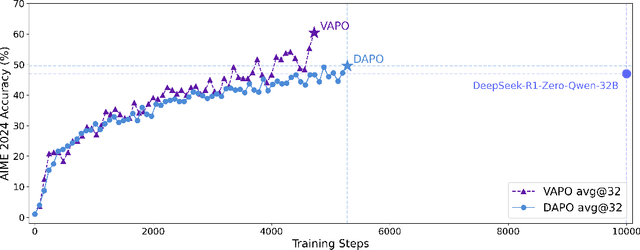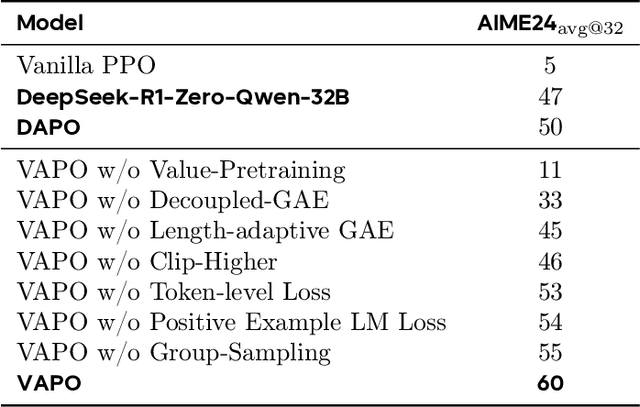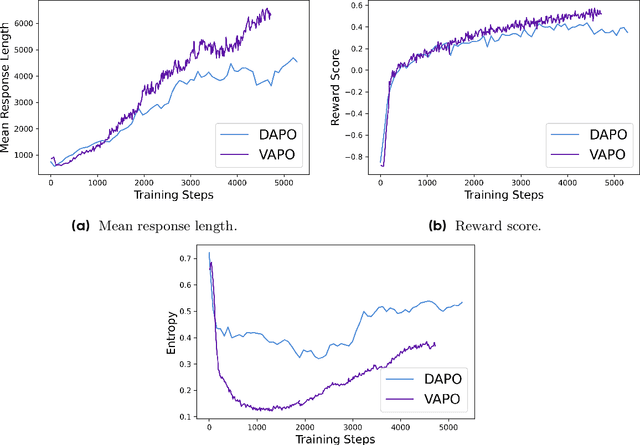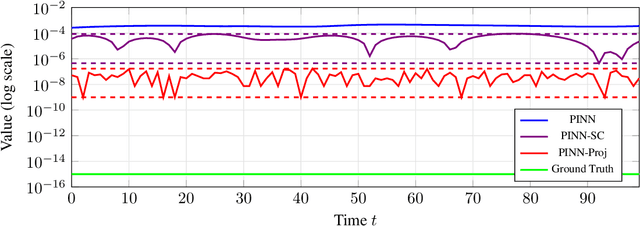Wang Zhang
Laminar: A Scalable Asynchronous RL Post-Training Framework
Oct 14, 2025Abstract:Reinforcement learning (RL) post-training for Large Language Models (LLMs) is now scaling to large clusters and running for extended durations to enhance model reasoning performance. However, the scalability of existing RL frameworks is limited, as extreme long-tail skewness in RL trajectory generation causes severe GPU underutilization. Current asynchronous RL systems attempt to mitigate this, but they rely on global weight synchronization between the actor and all rollouts, which creates a rigid model update schedule. This global synchronization is ill-suited for the highly skewed and evolving distribution of trajectory generation latency in RL training, crippling training efficiency. Our key insight is that efficient scaling requires breaking this lockstep through trajectory-level asynchrony, which generates and consumes each trajectory independently. We propose Laminar, a scalable and robust RL post-training system built on a fully decoupled architecture. First, we replace global updates with a tier of relay workers acting as a distributed parameter service. This enables asynchronous and fine-grained weight synchronization, allowing rollouts to pull the latest weight anytime without stalling the actor's training loop. Second, a dynamic repack mechanism consolidates long-tail trajectories onto a few dedicated rollouts, maximizing generation throughput. The fully decoupled design also isolates failures, ensuring robustness for long-running jobs. Our evaluation on a 1024-GPU cluster shows that Laminar achieves up to 5.48$\times$ training throughput speedup over state-of-the-art systems, while reducing model convergence time.
Measuring and Controlling the Spectral Bias for Self-Supervised Image Denoising
Oct 01, 2025Abstract:Current self-supervised denoising methods for paired noisy images typically involve mapping one noisy image through the network to the other noisy image. However, after measuring the spectral bias of such methods using our proposed Image Pair Frequency-Band Similarity, it suffers from two practical limitations. Firstly, the high-frequency structural details in images are not preserved well enough. Secondly, during the process of fitting high frequencies, the network learns high-frequency noise from the mapped noisy images. To address these challenges, we introduce a Spectral Controlling network (SCNet) to optimize self-supervised denoising of paired noisy images. First, we propose a selection strategy to choose frequency band components for noisy images, to accelerate the convergence speed of training. Next, we present a parameter optimization method that restricts the learning ability of convolutional kernels to high-frequency noise using the Lipschitz constant, without changing the network structure. Finally, we introduce the Spectral Separation and low-rank Reconstruction module (SSR module), which separates noise and high-frequency details through frequency domain separation and low-rank space reconstruction, to retain the high-frequency structural details of images. Experiments performed on synthetic and real-world datasets verify the effectiveness of SCNet.
TongUI: Building Generalized GUI Agents by Learning from Multimodal Web Tutorials
Apr 17, 2025Abstract:Building Graphical User Interface (GUI) agents is a promising research direction, which simulates human interaction with computers or mobile phones to perform diverse GUI tasks. However, a major challenge in developing generalized GUI agents is the lack of sufficient trajectory data across various operating systems and applications, mainly due to the high cost of manual annotations. In this paper, we propose the TongUI framework that builds generalized GUI agents by learning from rich multimodal web tutorials. Concretely, we crawl and process online GUI tutorials (such as videos and articles) into GUI agent trajectory data, through which we produce the GUI-Net dataset containing 143K trajectory data across five operating systems and more than 200 applications. We develop the TongUI agent by fine-tuning Qwen2.5-VL-3B/7B models on GUI-Net, which show remarkable performance improvements on commonly used grounding and navigation benchmarks, outperforming baseline agents about 10\% on multiple benchmarks, showing the effectiveness of the GUI-Net dataset and underscoring the significance of our TongUI framework. We will fully open-source the code, the GUI-Net dataset, and the trained models soon.
VAPO: Efficient and Reliable Reinforcement Learning for Advanced Reasoning Tasks
Apr 08, 2025


Abstract:We present VAPO, Value-based Augmented Proximal Policy Optimization framework for reasoning models., a novel framework tailored for reasoning models within the value-based paradigm. Benchmarked the AIME 2024 dataset, VAPO, built on the Qwen 32B pre-trained model, attains a state-of-the-art score of $\mathbf{60.4}$. In direct comparison under identical experimental settings, VAPO outperforms the previously reported results of DeepSeek-R1-Zero-Qwen-32B and DAPO by more than 10 points. The training process of VAPO stands out for its stability and efficiency. It reaches state-of-the-art performance within a mere 5,000 steps. Moreover, across multiple independent runs, no training crashes occur, underscoring its reliability. This research delves into long chain-of-thought (long-CoT) reasoning using a value-based reinforcement learning framework. We pinpoint three key challenges that plague value-based methods: value model bias, the presence of heterogeneous sequence lengths, and the sparsity of reward signals. Through systematic design, VAPO offers an integrated solution that effectively alleviates these challenges, enabling enhanced performance in long-CoT reasoning tasks.
DAPO: An Open-Source LLM Reinforcement Learning System at Scale
Mar 18, 2025Abstract:Inference scaling empowers LLMs with unprecedented reasoning ability, with reinforcement learning as the core technique to elicit complex reasoning. However, key technical details of state-of-the-art reasoning LLMs are concealed (such as in OpenAI o1 blog and DeepSeek R1 technical report), thus the community still struggles to reproduce their RL training results. We propose the $\textbf{D}$ecoupled Clip and $\textbf{D}$ynamic s$\textbf{A}$mpling $\textbf{P}$olicy $\textbf{O}$ptimization ($\textbf{DAPO}$) algorithm, and fully open-source a state-of-the-art large-scale RL system that achieves 50 points on AIME 2024 using Qwen2.5-32B base model. Unlike previous works that withhold training details, we introduce four key techniques of our algorithm that make large-scale LLM RL a success. In addition, we open-source our training code, which is built on the verl framework, along with a carefully curated and processed dataset. These components of our open-source system enhance reproducibility and support future research in large-scale LLM RL.
Prompt-SID: Learning Structural Representation Prompt via Latent Diffusion for Single-Image Denoising
Feb 10, 2025



Abstract:Many studies have concentrated on constructing supervised models utilizing paired datasets for image denoising, which proves to be expensive and time-consuming. Current self-supervised and unsupervised approaches typically rely on blind-spot networks or sub-image pairs sampling, resulting in pixel information loss and destruction of detailed structural information, thereby significantly constraining the efficacy of such methods. In this paper, we introduce Prompt-SID, a prompt-learning-based single image denoising framework that emphasizes preserving of structural details. This approach is trained in a self-supervised manner using downsampled image pairs. It captures original-scale image information through structural encoding and integrates this prompt into the denoiser. To achieve this, we propose a structural representation generation model based on the latent diffusion process and design a structural attention module within the transformer-based denoiser architecture to decode the prompt. Additionally, we introduce a scale replay training mechanism, which effectively mitigates the scale gap from images of different resolutions. We conduct comprehensive experiments on synthetic, real-world, and fluorescence imaging datasets, showcasing the remarkable effectiveness of Prompt-SID.
Spatiotemporal Blind-Spot Network with Calibrated Flow Alignment for Self-Supervised Video Denoising
Dec 16, 2024Abstract:Self-supervised video denoising aims to remove noise from videos without relying on ground truth data, leveraging the video itself to recover clean frames. Existing methods often rely on simplistic feature stacking or apply optical flow without thorough analysis. This results in suboptimal utilization of both inter-frame and intra-frame information, and it also neglects the potential of optical flow alignment under self-supervised conditions, leading to biased and insufficient denoising outcomes. To this end, we first explore the practicality of optical flow in the self-supervised setting and introduce a SpatioTemporal Blind-spot Network (STBN) for global frame feature utilization. In the temporal domain, we utilize bidirectional blind-spot feature propagation through the proposed blind-spot alignment block to ensure accurate temporal alignment and effectively capture long-range dependencies. In the spatial domain, we introduce the spatial receptive field expansion module, which enhances the receptive field and improves global perception capabilities. Additionally, to reduce the sensitivity of optical flow estimation to noise, we propose an unsupervised optical flow distillation mechanism that refines fine-grained inter-frame interactions during optical flow alignment. Our method demonstrates superior performance across both synthetic and real-world video denoising datasets. The source code is publicly available at https://github.com/ZKCCZ/STBN.
Guaranteeing Conservation Laws with Projection in Physics-Informed Neural Networks
Oct 22, 2024

Abstract:Physics-informed neural networks (PINNs) incorporate physical laws into their training to efficiently solve partial differential equations (PDEs) with minimal data. However, PINNs fail to guarantee adherence to conservation laws, which are also important to consider in modeling physical systems. To address this, we proposed PINN-Proj, a PINN-based model that uses a novel projection method to enforce conservation laws. We found that PINN-Proj substantially outperformed PINN in conserving momentum and lowered prediction error by three to four orders of magnitude from the best benchmark tested. PINN-Proj also performed marginally better in the separate task of state prediction on three PDE datasets.
HybridFlow: A Flexible and Efficient RLHF Framework
Sep 28, 2024



Abstract:Reinforcement Learning from Human Feedback (RLHF) is widely used in Large Language Model (LLM) alignment. Traditional RL can be modeled as a dataflow, where each node represents computation of a neural network (NN) and each edge denotes data dependencies between the NNs. RLHF complicates the dataflow by expanding each node into a distributed LLM training or generation program, and each edge into a many-to-many multicast. Traditional RL frameworks execute the dataflow using a single controller to instruct both intra-node computation and inter-node communication, which can be inefficient in RLHF due to large control dispatch overhead for distributed intra-node computation. Existing RLHF systems adopt a multi-controller paradigm, which can be inflexible due to nesting distributed computation and data communication. We propose HybridFlow, which combines single-controller and multi-controller paradigms in a hybrid manner to enable flexible representation and efficient execution of the RLHF dataflow. We carefully design a set of hierarchical APIs that decouple and encapsulate computation and data dependencies in the complex RLHF dataflow, allowing efficient operation orchestration to implement RLHF algorithms and flexible mapping of the computation onto various devices. We further design a 3D-HybridEngine for efficient actor model resharding between training and generation phases, with zero memory redundancy and significantly reduced communication overhead. Our experimental results demonstrate 1.53$\times$~20.57$\times$ throughput improvement when running various RLHF algorithms using HybridFlow, as compared with state-of-the-art baselines. HybridFlow source code is available at https://github.com/volcengine/verl.
SEMDR: A Semantic-Aware Dual Encoder Model for Legal Judgment Prediction with Legal Clue Tracing
Aug 19, 2024



Abstract:Legal Judgment Prediction (LJP) aims to form legal judgments based on the criminal fact description. However, researchers struggle to classify confusing criminal cases, such as robbery and theft, which requires LJP models to distinguish the nuances between similar crimes. Existing methods usually design handcrafted features to pick up necessary semantic legal clues to make more accurate legal judgment predictions. In this paper, we propose a Semantic-Aware Dual Encoder Model (SEMDR), which designs a novel legal clue tracing mechanism to conduct fine-grained semantic reasoning between criminal facts and instruments. Our legal clue tracing mechanism is built from three reasoning levels: 1) Lexicon-Tracing, which aims to extract criminal facts from criminal descriptions; 2) Sentence Representation Learning, which contrastively trains language models to better represent confusing criminal facts; 3) Multi-Fact Reasoning, which builds a reasons graph to propagate semantic clues among fact nodes to capture the subtle difference among criminal facts. Our legal clue tracing mechanism helps SEMDR achieve state-of-the-art on the CAIL2018 dataset and shows its advance in few-shot scenarios. Our experiments show that SEMDR has a strong ability to learn more uniform and distinguished representations for criminal facts, which helps to make more accurate predictions on confusing criminal cases and reduces the model uncertainty during making judgments. All codes will be released via GitHub.
 Add to Chrome
Add to Chrome Add to Firefox
Add to Firefox Add to Edge
Add to Edge